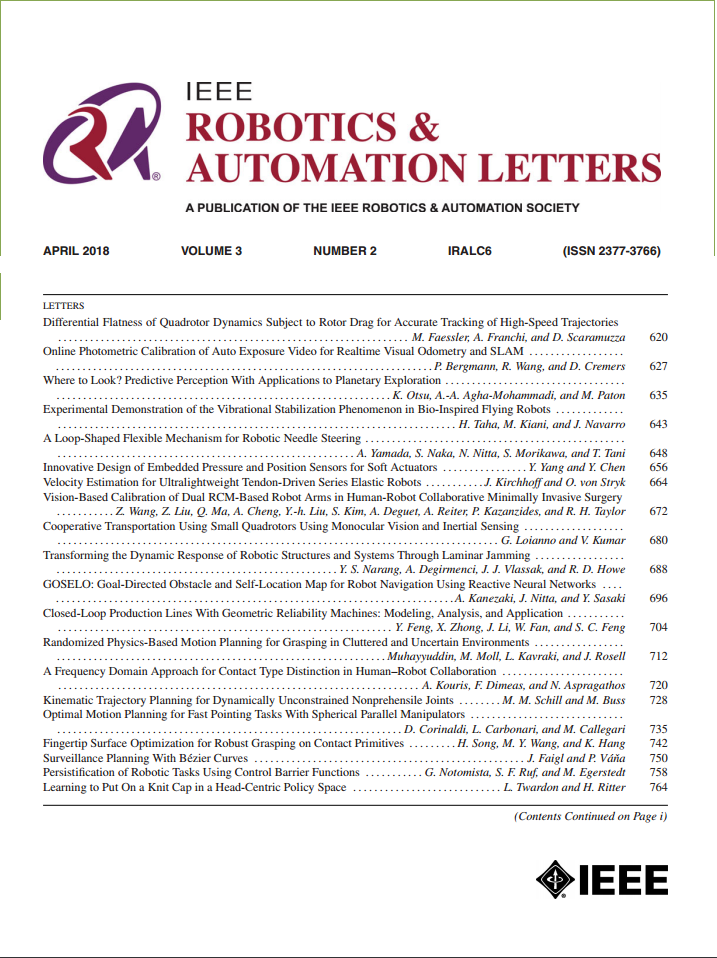FWAF-VID:扑翼冲击飞行视觉惯性定位基准数据集
IF 4.6
2区 计算机科学
Q2 ROBOTICS
引用次数: 0
摘要
高速动态环境下微型飞行器(MAVs)的精确状态估计对视觉惯性里程计(VIO)算法提出了重大挑战。扑翼飞行器作为一种新兴的飞行平台,其隐身性能和高效的飞行特性引起了人们的广泛关注。尽管有许多MAV视觉惯性数据集可用于六自由度(6-DoF)状态估计,但这些数据集不适用于具有明显振动和灵活机动的fwave。为了解决这一差距,我们提出了一个大规模扑翼攻击飞行视觉惯性数据集FWAF-VID。它包含同步机载摄像机和IMU传感器的多种集成。总共28个序列包括静态扑动、校准和在室外和室内环境中收集的真实飞行。17个飞行序列在照明,速度,轨迹,相机视角和飞行方式的变化。我们为算法评估提供精确对齐的地面真值RTK和UWB测量。此外,进行了全面的基准比较,定性和定量地评价了最先进的VIO算法的定位精度。实验结果表明,尽管在高动态环境下定位精度会下降,但FWAF-VID可以有效地支持面向fwas的VIO算法的进一步发展。据我们所知,这是第一个为扑翼机载平台的攻击性飞行量身定制的机载基准数据集。本文章由计算机程序翻译,如有差异,请以英文原文为准。
FWAF-VID: A Flapping-Wing Aggressive Flight Benchmark Dataset for Visual-Inertial Localization
Accurate state estimation of micro aerial vehicles (MAVs) in high-speed and dynamic environments poses a significant challenge for visual-inertial odometry (VIO) algorithms. Flapping-wing aerial vehicles (FWAVs), as an emerging flight platform, have attracted significant attention for stealth capabilities and efficient flight characteristics. Despite the availability of numerous MAV visual-inertial datasets for six-degree-of-freedom (6-DoF) state estimation, these datasets are not applicable for FWAVs with pronounced vibrations and agile maneuverability. To address this gap, we propose a large-scale flapping-wing aggressive flight visual-inertial dataset FWAF-VID. It contains diverse integrations of synchronized onboard cameras and IMU sensors. A total of 28 sequences include static flapping, calibration, and real-world flights collected in outdoor and indoor environments. The 17 flight sequences feature variations in illuminations, speeds, trajectories, camera perspectives, and flight modalities. We provide precisely aligned ground truth RTK and UWB measurements for algorithm evaluation. Furthermore, a comprehensive benchmark comparison is conducted, qualitatively and quantitatively evaluating the positioning accuracy of state-of-the-art VIO algorithms. The experimental results indicate that despite the degradation in localization accuracy in high-dynamic environments, FWAF-VID can effectively support the further development of VIO algorithms for FWAVs. To the best of our knowledge, this is the first onboard benchmark dataset tailored for aggressive flight in flapping-wing airborne platforms.
求助全文
通过发布文献求助,成功后即可免费获取论文全文。
去求助
来源期刊

IEEE Robotics and Automation Letters
Computer Science-Computer Science Applications
CiteScore
9.60
自引率
15.40%
发文量
1428
期刊介绍:
The scope of this journal is to publish peer-reviewed articles that provide a timely and concise account of innovative research ideas and application results, reporting significant theoretical findings and application case studies in areas of robotics and automation.
 求助内容:
求助内容: 应助结果提醒方式:
应助结果提醒方式:


